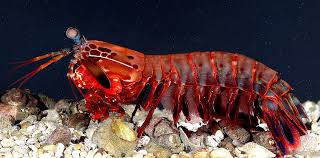Syllabus:
GS3: Awareness in the fields of IT, Space, Computers, Robotics, Nano-technology, Bio-technology and issues relating to intellectual property rights.
Context:
A team of researchers from the US and France found that the mantis shrimps can block or control mechanical waves to avoid hurting themselves when they strike their prey.
Key Findings
- The findings, published in the journal Science Advances, are the first to demonstrate passive underwater global positioning (GPS) using the polarisation properties of underwater light.
- The researcher investigated this behaviour by sending waves through the structure and analysed how they interacted with the material.
- The mantis shrimp’s remarkable self-protection in a specialized microstructure within its dactyl club.
- This structure exhibits phononic shielding — a unique ability that dampens the flow of acoustic waves, thereby reducing the recoil the shrimp experiences during its high-speed strikes.
- These shrimps use a hammer-shaped appendage called the dactyl club or Raptorial appendage to strike their prey at a blistering 23 m/s (about 50 times faster than the blink of an eye).
- The strike releases enough energy to send small shockwaves through the surrounding water, still the mantis shrimp remains unharmed.

Dynamic mechanical behaviour
- The mantis shrimp’s dactyl club stores energy in spring-like elastic structures, which are held by latch-like tendons and release suddenly to deliver a powerful, rapid strike.
- As the club punches forward, it displaces surrounding water and creates low-pressure zones where the water turns into vapor, forming bubbles in the shrimp’s path.
- These vapor bubbles collapse quickly under water pressure, releasing intense heat and shockwaves that can reach frequencies of hundreds of megahertz.
- Each strike delivers two powerful blows: one from the club itself and another from the collapsing bubbles, allowing the mantis shrimp to break tough prey shells easily.
Self-protection of the Shrimps
- The researchers found that the dactyl club was capable of phononic shielding.
- This shield, a multi-layered structure, selectively filters out damaging shockwaves, allowing the shrimp to strike with bullet-like speed without breaking their exoskeleton.
- The team fired laser pulses at the microstructure in a rapid sequence that illuminated its response at less than one-billionth of a second at a time.
Mantis Shrimps
- Mantis shrimp are ancient marine crustaceans from the order Stomatopoda, especially members of the genus Squilla.
- There are over 450 known species, ranging in size from about 10 cm to nearly 46 cm.
- They’re known for their bright colors, interesting behavior, and strong limbs used for hunting. Even though they’re called shrimp, mantis shrimp aren’t real shrimp.
- Mantis shrimp are not generally listed by the International Union for Conservation of Nature (IUCN) as a whole group, but individual species within the order may be assessed individually.
- Mantis shrimp are primarily found in shallow, tropical and subtropical marine waters, often near coral reefs and sandy areas, particularly in the Indian and Pacific Oceans.


